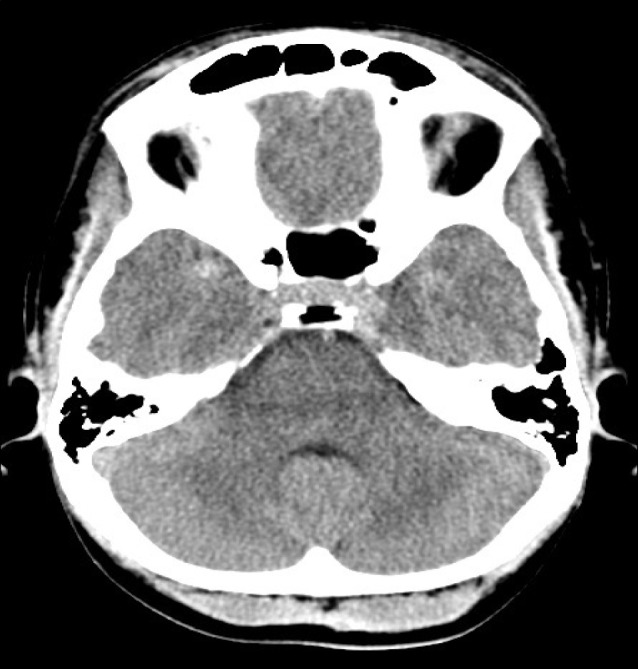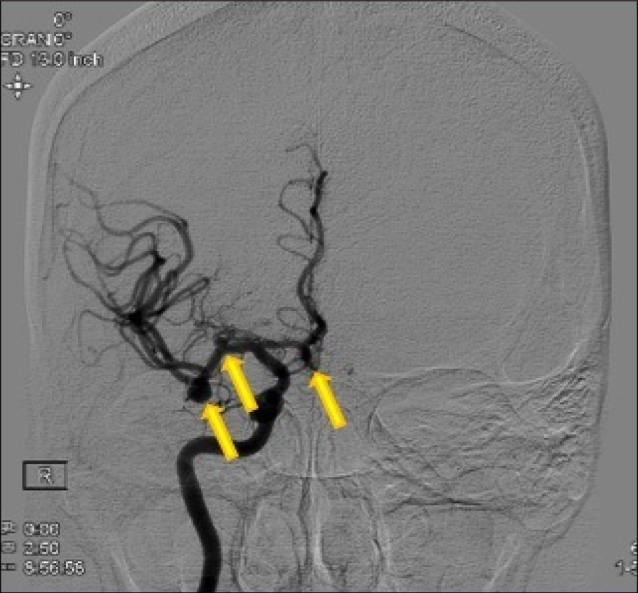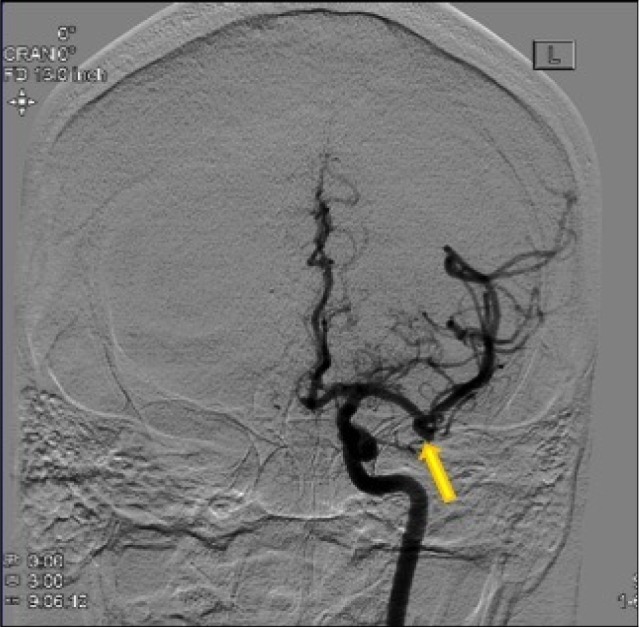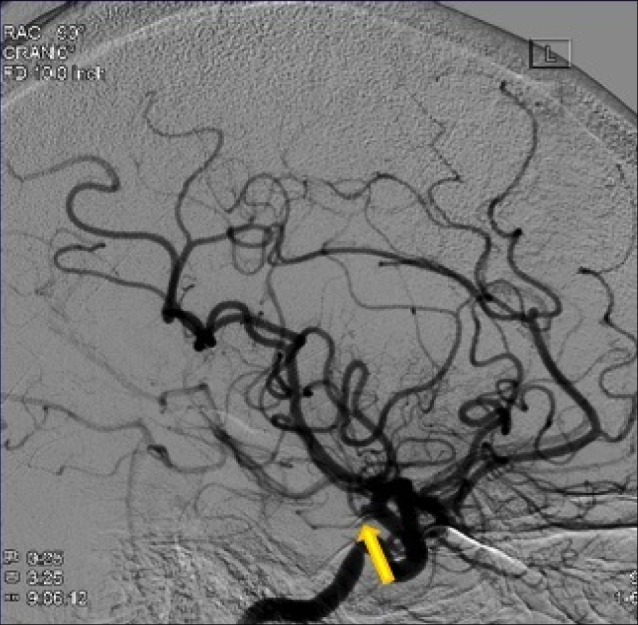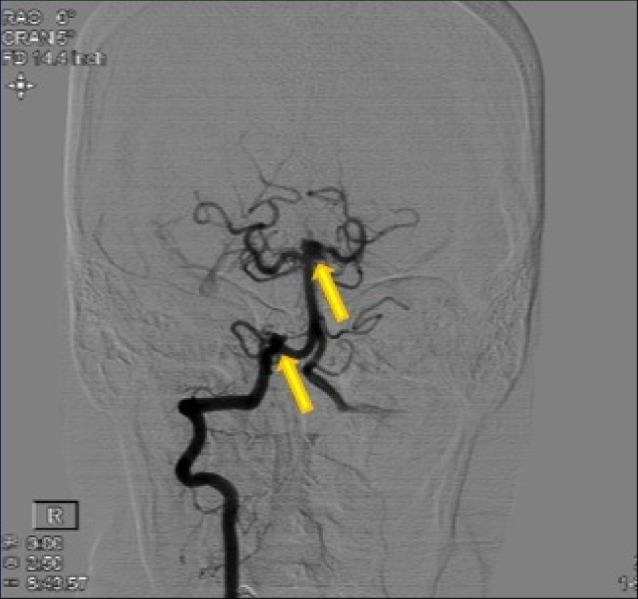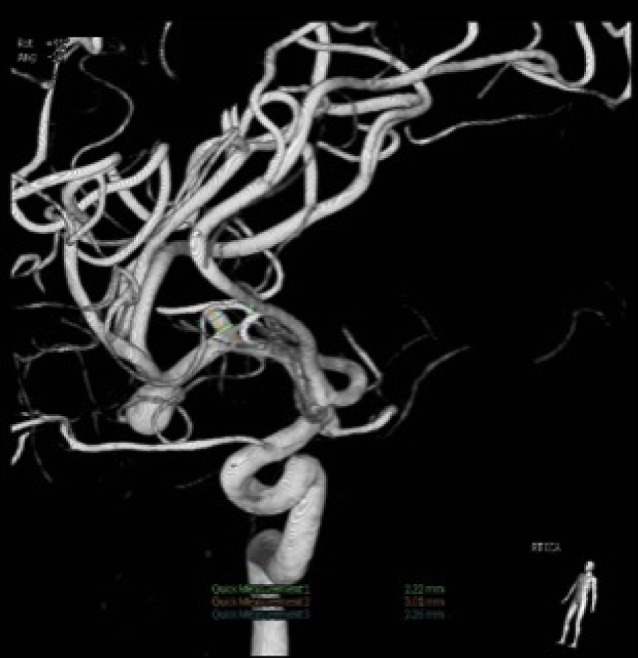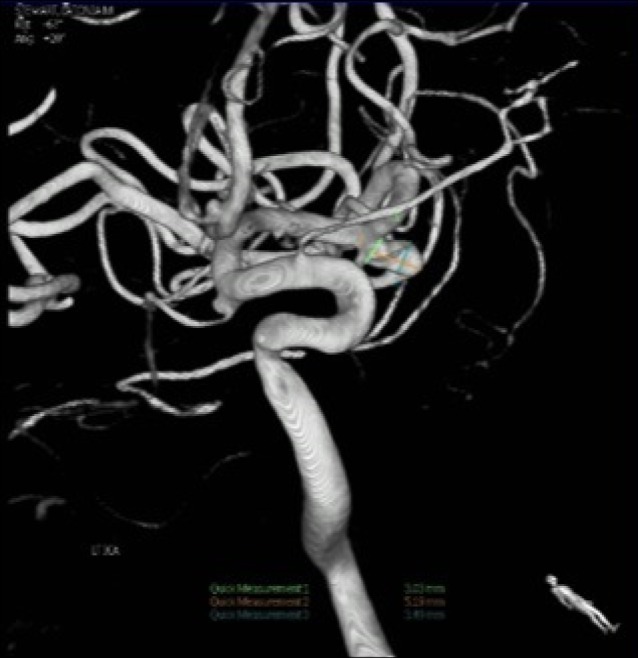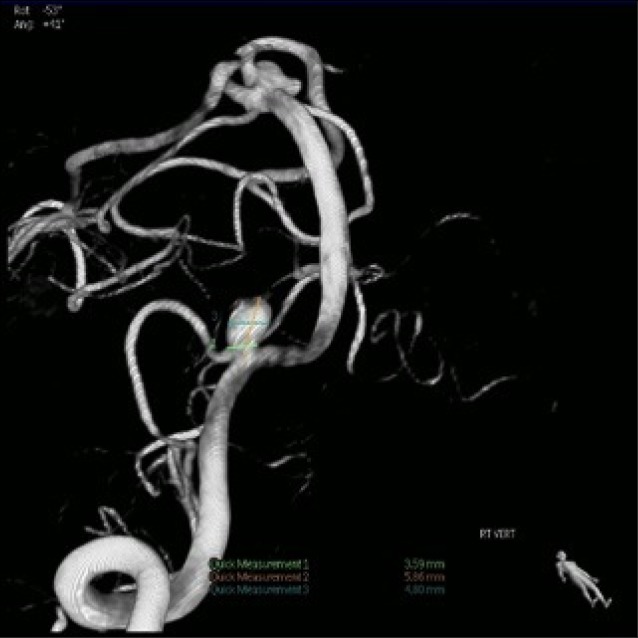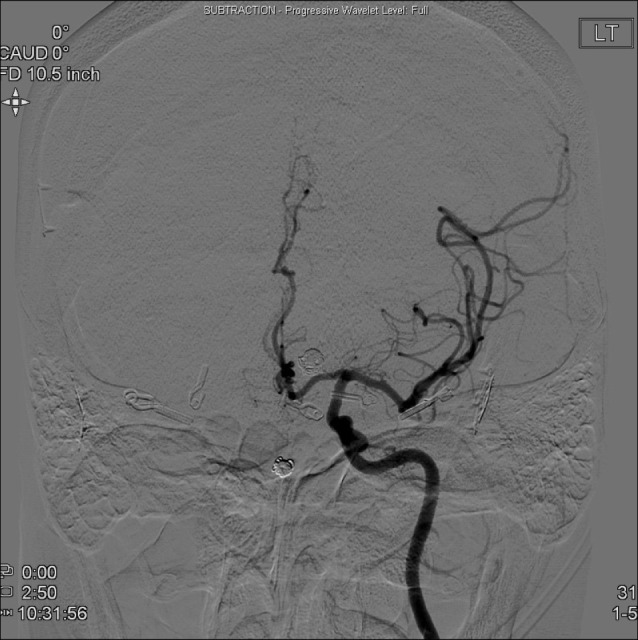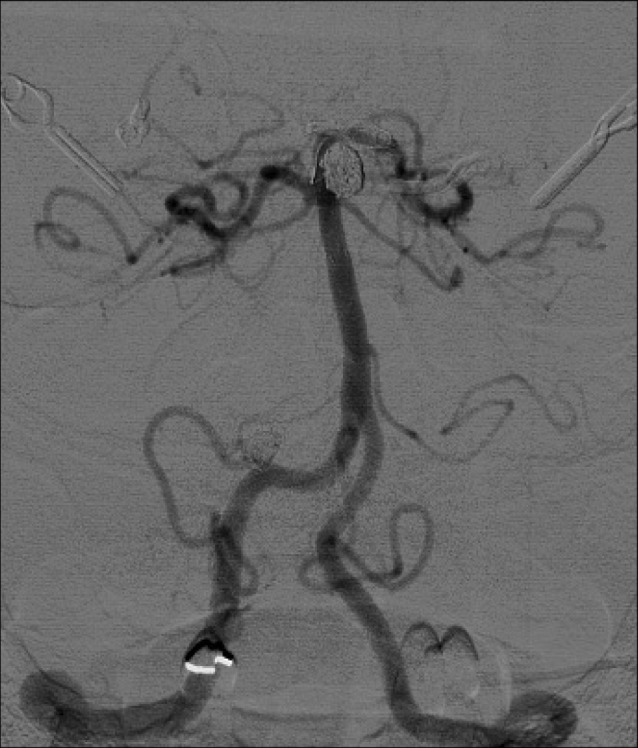J Cerebrovasc Endovasc Neurosurg.
2015 Jun;17(2):113-119. 10.7461/jcen.2015.17.2.113.
Seven Intracranial Aneurysms in One Patient: Treatment and Review of Literature
- Affiliations
-
- 1Department of Neurosurgery, Louisiana State University Health Sciences Center, Shreveport, LA, USA. oahmed@lsuhsc.edu
- KMID: 1879343
- DOI: http://doi.org/10.7461/jcen.2015.17.2.113
Abstract
- Before the advent of endovascular coiling, patients with multiple intracranial aneurysms were treated with surgical clipping; however, with the advancements in endovascular technology, intracranial aneurysms can be treated with surgical clipping and/or endovascular coiling. We describe a case of subarachnoid hemorrhage in a patient with 7 intracranial aneurysms. A 45-year-old female developed a sudden headache and left sided hemiparesis. Initial workup showed a subarachnoid hemorrhage in the right Sylvian fissure. Further angiographic workup showed 7 intracranial aneurysms (left and right middle cerebral artery bifurcation, right middle cerebral artery, anterior communicating artery, left posterior communicating artery, right posterior inferior cerebellar artery, and left superior cerebellar artery). The patient underwent two craniotomies for surgical clipping of the anterior circulation aneurysms and endovascular stent-assisted coils for the posterior circulation aneurysms. The need for anti-platelet agents for endovascular treatment of the posterior circulation aneurysms and clinical presentation warranted surgical clipping of the anterior circulation aneurysms prior to endovascular therapy. We describe a case report and decision making for a patient with multiple intracranial aneurysms treated with surgical clipping and endovascular coiling.
Keyword
MeSH Terms
Figure
Reference
-
1. Baumann F, Khan N, Yonekawa Y. Patient and aneurysm characteristics in multiple intracranial aneurysms. Acta Neurochir Suppl. 2008; 103:19–28. PMID: 18496941.
Article2. Bederson JB, Awad IA, Wiebers DO, Piepgras D, Haley EC Jr, Brott T, et al. Recommendations for the management of patients with unruptured intracranial aneurysms: A Statement for healthcare professionals from the Stroke Council of the American Heart Association. Stroke. 2000; 11. 31(11):2742–2750. PMID: 11062304.3. Chyatte D, Fode NC, Sundt TM Jr. Early versus late intracranial aneurysm surgery in subarachnoid hemorrhage. J Neurosurg. 1988; 9. 69(3):326–331. PMID: 3404227.
Article4. de Gans K, Nieuwkamp DJ, Rinkel GJ, Algra A. Timing of aneurysm surgery in subarachnoid hemorrhage: a systematic review of the literature. Neurosurgery. 2002; 2. 50(2):336–342. discussion 340-2PMID: 11844269.
Article5. Ellamushi HE, Grieve JP, Jager HR, Kitchen ND. Risk factors for the formation of multiple intracranial aneurysms. J Neurosurg. 2001; 5. 94(5):728–732. PMID: 11354403.
Article6. Findlay JM. Current management of aneurysmal subarachnoid hemorrhage guidelines from the Canadian Neurosurgical Society. Can J Neurol Sci. 1997; 5. 24(2):161–170. PMID: 9164696.7. Heiskanen O. Risk of rebleeding from unruptured aneurysm in cases with multiple intracranial aneurysms. J Neurosurg. 1981; 10. 55(4):524–526. PMID: 7277000.8. Hong T, Wang Y. Unilateral approach to clip bilateral multiple intracranial aneurysms. Surg Neurol. 2009; 8. 72(Suppl 1):S23–S28. PMID: 18514280.
Article9. Imhof HG, Yonekawa Y. Management of ruptured aneurysms combined with coexisting aneurysms. Acta Neurochir Suppl. 2005; 94:93–96. PMID: 16060246.
Article10. Inagawa T, Hirano A. Autopsy study of unruptured incidental intracranial aneurysms. Surg Neurol. 1990; 12. 34(6):361–365. PMID: 2244298.
Article11. Inagawa T. Surgical treatment of multiple intracranial aneurysms. Acta Neurochir (Wien). 1991; Jan-Feb. 108(1-2):22–29. PMID: 2058422.
Article12. Isaksen J, Egge A, Waterloo K, Romner B, Ingebrigtsen T. Risk factors for aneurysmal subarachnoid hemorrhage: the Tromso study. J Neurol Neurosurg Psychiatry. 2002; 8. 73(2):185–187. PMID: 12122180.13. Jeon P, Kim BM, Kim DJ, Kim DI, Suh SH. Treatment of multiple intracranial aneurysms with 1-stage coiling. AJNR Am J Neuroradiol. 2014; 6. 35(6):1170–1173. PMID: 24371032.
Article14. Juvela S, Porras M, Heiskanen O. Natural history of unruptured intracranial aneurysms: a long-term follow-up study. J Neurosurg. 1993; 8. 79(2):174–182. PMID: 8331397.
Article15. Juvela S. Prevalence of risk factors in spontaneous intracerebral hemorrhage and aneurysmal subarachnoid hemorrhage. Arch Neurol. 1996; 8. 53(8):734–740. PMID: 8759979.
Article16. Kassell NF, Torner JC, Jane JA, Haley EC Jr, Adams HP. The international cooperative study on the timing of aneurysm surgery. Part 2: surgical results. J Neurosurg. 1990; 7. 73(1):37–47. PMID: 2191091.17. Laidlaw JD, Siu KH. Ultra-early surgery for aneurysmal subarachnoid hemorrhage: outcomes for a consecutive series of 391 patients not selected by grade or age. J Neurosurg. 2002; 8. 97(2):250–258. PMID: 12186450.
Article18. Lawton MT, Quinones-Hinojosa A, Sanai N, Malek JY, Dowd CF. Combined Microsurgical and Endovascular Management of Complex Intracranial Aneurysms. Neurosurgery. 2003; 2. 52(2):263–274. discussion 274-5PMID: 12535354.
Article19. McCormick WF, Acosta-Rua GJ. The size of intracranial saccular aneurysms. An autopsy study. J Neurosurg. 1970; 10. 33(4):422–427. PMID: 5471931.20. Mizoi K, Suzuki J, Yoshimoto T. Surgical treatment of multiple aneurysms: review of experience with 372 cases. Acta Neurochir (Wien). 1989; Jan-Feb. 96(1-2):8–14. PMID: 2929394.21. Mount LA, Brisma R. Treatment of multiple intracranial aneurysms. J Neurosurg. 1971; 12. 35(6):728–730. PMID: 5117224.
Article22. Nieuwkamp DJ, Setz LE, Algra A, Linn FH, de Rooij NK, Rinkel GJ. Changes in case fatality of aneurysmal subarachnoid hemorrhage over time, according to age, sex, and region: a meta-analysis. Lancet Neurol. 2009; 7. 8(7):635–642. PMID: 19501022.23. Qureshi AI, Suarez JI, Parekh PD, Sung G, Geocadin R, Bhardwaj A, et al. Risk factors for multiple intracranial aneurysms. Neurosurgery. 1998; 7. 43(1):22–27. PMID: 9657184.
Article24. Rinne J, Hernesniemi J, Puranen M, Saari T. Multiple intracranial aneurysms in a defined population: prospective angiographic and clinical study. Neurosurgery. 1994; 11. 35(5):803–808. PMID: 7838326.25. Solander S, Ulhoa A, Vinuela F, Duckwiler GR, Gobin YP, Martin NA, et al. Endovascular treatment of multiple intracranial aneurysms by using Guglielmi detachable coils. J Neurosurg. 1999; 5. 90(5):857–864. PMID: 10223451.
Article26. Stehbens WE. Etiology of intracranial berry aneurysms. J Neurosurg. 1989; 6. 70(6):823–831. PMID: 2654334.
Article27. Vajda J. Multiple intracranial aneurysms: a high risk condition. Acta Neurochir (Wien). 1992; Jan-Feb. 118(1-2):59–75. PMID: 1414531.
Article28. Whitfield PC, Kirkpatrick PJ. Timing of surgery for aneurysmal subarachnoid haemorrhage. Cochrane Database Syst Rev. 2001; (2):CD001697. PMID: 11405999.
Article29. Winn HR, Almaani WS, Berga SL, Jane JA, Richardson AE. The long-term outcome in patients with multiple aneurysms. Incidence of late hemorrhage and implications for treatment of incidental aneurysms. J Neurosurg. 1983; 10. 59(4):642–651. PMID: 6886785.
- Full Text Links
- Actions
-
Cited
- CITED
-
- Close
- Share
- Similar articles
-
- Surgical Management of Intracranial Aneurysms in the Endovascular Era : Review Article
- Guideline for Management of Unruptured Intracranial Aneurysms: Preliminary Report
- Clinical Experience of Thromboembolic Complications of Coil Embolization for Intracranial Aneurysms with Literature Review
- Comprehension of Two Modalities: Endovascular Coiling and Microsurgical Clipping in Treatment of Intracranial Aneurysms
- Current Update on the Randomized Controlled Trials of Intracranial Aneurysms

